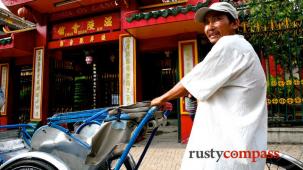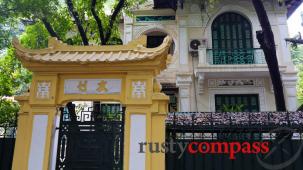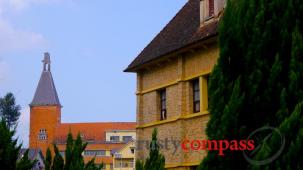There is something hideously perverse about turning a school into a torture camp. At Tuol Sleng in downtown Phnom Penh, that’s what happened at the hands of the Khmer Rouge in the 1970s. The camp, known as S-21 is now preserved as the Tuol Sleng Museum. It’s the most moving of all the museums in Indochina. It tells both of the horrors of the camp and provides a moving and challenging context for one of the twentieth century’s darkest stories. Do not miss this museum.
A tour guide explains the prison. The Khmer Rouge reign of terror is so recent that many tour guides can share very personal accounts of the period.
The camp has been largely left as it was when it was liberated by Vietnamese troops in 1979. Chilling photos taken by a Vietnamese military photographer are on the walls of some of the chambers.
The Khmer Rouge scrupulously documented the prisoners of S-21 and the museum features several galleries of macabre images of its victims.
- A number of foreigners were amongst the victims of S-21
Irons used for restraining prisoners.
One of the survivors of S21 was a sculptor who was commissioned to make these busts of Pol Pot which sit in a cage in one of the chambers.
Cambodia has a relatively open discussion about events that preceded and followed the Communist takeover in 1975. The Tuol Sleng Museum gives voice both to the survivors of S21 and their former captors.
A later addition to the museum upstairs provides some much needed historical context to the rise of the Khmer Rouge. Remarkably though, I found no reference to the ongoing recognition that western nations - including the US, the UK and Australia - gave to the Khmer Rouge after the brutality of the regime started to become apparent. Many say that this was to spite the Vietnamese who had triumphed against the US. The Vietnamese were bitter enemies of the Khmer Rouge by the time they came to power in 1975.
The flag of Khmer Rouge era Cambodia and some other propaganda items.
This extract is from the Khmer Rouge national anthem. It reads - “Glittering red blood which blankets the towns and countryside of the Kampuchean motherland! Blood of our splendid workers and peasants. Blood of our revolutionary youth! Blood that was transmuted into fury, anger and vigourous struggle! On 17 April, blood that liberated us from slavery! Long live 17 April, the great victory! More wonderful and much more meaningful than the Angkar era! We unite together to build up Kampuchea and a glorious society, democratic, egalitarian and just; Independent - master; absolutely determined to defend the country, our glorious land;"
An account of a former S-21 guard. He says, “When I worked at S-21, I did not have the motivation, but I had to, otherwise I wouldn’t live. However, no matter which option I chose, I still feared. There was nothing I could do”.
This former guard said “All Khmer Rouge leaders who said that they were not aware of the existence of Tuol Sleng prison are trying to defend themselves, because they worked with Pol Pot, the founder of this one square kilometre compound. They must not accuse small people and hide their own crimes. This is unfair. The villagers called me pro Pol Pot. I do not mind them since it is true that I worked for the Khmer Rouge. Most villagers know I worked in Tuol Sleng Prison. I was not regretful, but I am sympathetic to my wife and my kids.”
Skulls of S-21 victims.
Barbed wire encloses the former classrooms.
Many travellers choose to combine their visit to the Tuol Sleng Museum with a visit to the Killing Fields at Choeung Ek about 17kms from central Phnom Penh. It is here that an estimated 17,000 prisoners from Tuol Sleng were executed.
The victims were buried in mass graves which were uncovered after the fall of the Khmer Rouge. Many of the skulls are now contained in this memorial.
Killing fields at Choeung Ek.
The shallow graves that to this day show fragments of bone and clothes.
Cheoung Ek may give greater depth to an understanding of the horrors of the Khmer Rouge rule but it need not be an essential part of a stay in Phnom Penh. Many travellers after visiting both sites take the view that the Tuol Sleng memorial is more meaningful. In a bizarre decision, the Cambodian government “privatised” the Killing Fields site in 2005. A Japanese company now operates the site as a commercial venture. An awareness of this also dissuades many travellers from visiting.

































